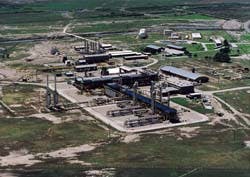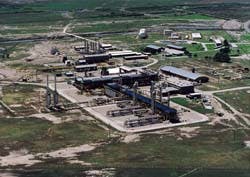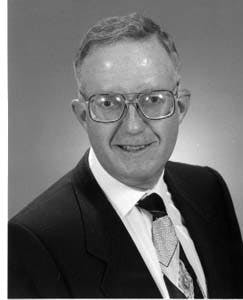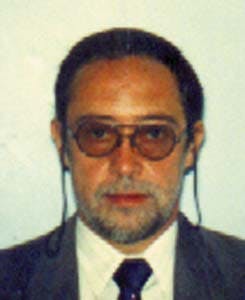Argentine plant increases capacity, improves NGL recoveries
Joe T. Lynch
Ortloff Engineers Ltd. Midland, Tex.César L. Fernández
C&F Engineering S.A. Buenos Aires
TGS' Cerri complex is receiving a third processing train that will raise its inlet capacity to more than 1.4 bcfd and improve ethane recovery.Total cryogenic processing capacity at Transportadora de Gas del Sur S.A.'s (TGS) Cerri complex in Bah!a Blanca, Argentina, is being increased from 22 MMcmd to 40 MMcmd (776 to 1,410 MMcfd) with a future ethane-recovery capacity of 1,900 metric tons/day (mtd; 33,600 b/d) using Ortloff technology.
Very high propane recovery can be maintained as the ethane recovery is controlled over a range of 1,000-1,900 mtd as needed to meet local ethane demand. Total NGL recovery can be increased from 2,600 mtd to 4,500 mtd without additional compression.
Current operation
TGS' Cerri complex has two cryogenic gas-processing trains to extract ethane and heavier hydrocarbon components from Neuba I and San Martin pipeline gas. A small amount of Neuba II pipeline gas is also being processed.Total cryogenic processing train capacity averages 22 MMcmd with a nominal ethane recovery of 1,000 mtd and total NGL recovery of 2,600 mtd. As much as 18 MMcmd of Neuba II pipeline gas bypasses Cerri during the peak demand winter months.
By using the latest process technology, TGS can recover an additional 1,945 mtd (27,700 b/d) of liquids from the three pipelines without adding compression. The company is building a state-of-the-art third cryogenic processing train and will upgrade the two trains as needed to allow cryogenic processing of up to 1.4 bcfd of gas during the peak demand months (OGJ, May 26, 1997, p. 64).
The two existing cryogenic processing trains were originally designed to process 9 MMcmd of gas per train, 18 MMcmd total. The two trains have common inlet separation, inlet compression, dehydration, and residue compression systems all sized for 18 MMcmd.
The original process design is an industry standard single-stage (ISS) design without refrigeration (Fig. 1 [63,879 bytes]). The expander-driven booster compressor is in residue-compression service, and shell-and-tube heat exchangers are used for all but aircooled services.
The original process design and the existing compression equipment have allowed operation at 22 MMcmd or 22% over the original design with an ethane recovery of 73%. Table 1 [13,634 bytes]shows a comparison of original-design data and nominal current operating data.
The trains were designed for a richer gas composition than is currently being processed. NGL-production volumes average close to the original design values but at a higher gas throughput because of the leaner gas.
The present operation maximizes propane and heavier NGL production while meeting a nominal local ethane-delivery requirement of 1,000 mtd. Higher ethane production is possible if the trains are operated at a total throughput of less than 22 MMcmd, but the total production of propane and heavier components is then reduced proportionally.
If the two trains are operated at a total throughput greater than 22 MMcmd, propane and heavier liquids production increases, but the ethane recovery drops and the 1,000 mtd ethane-production requirement cannot be met.
Limitations in the existing ISS plant design at the current 22-MMcmd through put include the following:
- The expander bypass (Joule-Thomson) valve in each train is partially open at the higher-than-design through put and lower-than-design expansion ratio.
- Pressure drops and velocities are much higher than design in the inlet and residue compression and separation piping systems.
- After regeneration-cycle optimization, the practical capacity of the existing six-bed dehydration system is 24 MMcmd.
The dehydration system limit of 24 MMcmd established a practical upper limit to the redesign throughput regardless of any process modifications or additional compression capacity.
Inlet-residue compression
A preliminary study of the existing compression indicated that two of the three existing compressor trains could be restaged and used with the two existing process trains, leaving a third compressor train available for service with a new process train designed for nearly all Neuba II pipeline gas.Each of the three existing compressor trains consists of a GE Frame 5 driver rated at 24,000 hp, an Elliot (Elliot Co., Jeannette, Pa.) barrel compressor for residue compression, and an Elliot barrel compressor for inlet compression.
Table 2 [8,891 bytes] summarizes the original-design information and the current operating parameters for the existing compression equipment.
Increasing total facility throughput requires making the best use of all the compression horsepower available from the three gas turbines. There are approximately 21,300 hp available (3 x 7,100) which were not used in the original compressor specification.
The maximum rerated throughput, however, is limited by the mechanical design of the original compressors rather than by the driver horsepower. Downtime and cost considerations required that the compressor options be limited to, at most, replacement of the serviceable bundle assemblies while existing compressor bodies were reused.
Elliot identified the following constraints on the maximum possible rerated capacity of the compressors:
- The original shaft diameter limits torque capacity, especially on the inboard residue-gas compressor shaft, which transmits torque to the outboard inlet-gas compressor.
- The existing nozzle sizes limit volumetric flow capacity.
- The existing barrel diameter limits the maximum wheel diameter.
- The existing barrel length limits the number of wheels of a given width that can be installed.
An increase in the residue-compressor shaft size was required to achieve this capacity. The number of impellers was reduced to allow room for the wider impellers required at the higher flow rates.
Fewer impellers result in less head available for the process. The reduction in available head will result in lower ethane recovery at the higher train inlet rate until the process retrofit is completed, but the propane and heavier production will increase with the plant inlet rate.
Trains A and B retrofit
Ortloff's Gas Subcooled Process (GSP) technology was chosen for TGS' two existing cryogenic processing trains using two rerated compressors. Higher ethane recovery is possible with the GSP design for a given horsepower than can be achieved with the ISS design. 1Many ethane-recovery plants built in recent years have used this technology, and many older plants have been successfully upgraded with the GSP design (OGJ, June 3, 1996, p. 41).
The GSP retrofit design (Fig. 2 [66,811 bytes]) requires additions to the existing ISS design of an absorber column, absorber bottoms pumps, and a reflux exchanger.
The new absorber column effectively becomes an extension of the existing demethanizer column and provides several fractionation stages above the expander feed location. A portion of the cool inlet gas is condensed by cold residue gas and used for absorber-column reflux. All the existing exchangers are reused in the retrofit design.
The two rewheeled compressor trains and the dehydration system limit the throughput of the retrofit design to a maximum of 12 MMcmd/train. The product recoveries and performance for the existing trains with and without the retrofit are compared in Table 3 [13,005 bytes].
The compressors, expander performance, and pressure-drop problems identified earlier are assumed to have been addressed identically for both designs so that the only difference in the results is due to the addition of the GSP retrofit process design to the debottlenecked ISS design.
Note that the compressor rerate and the debottlenecking modifications alone will allow total NGL production for the ISS design to be maintained at the current level of 2,600 mtd with two compressor trains rather than three.
The ethane recovery, however, drops from 73% at 11 MMcmd (Table 1) to 63% at the 12-MMcmd throughput because of the reduction in the expansion ratio with the two rerated compressor trains.
Ethane production improves significantly, however, when the GSP retrofit is installed. The 27% improvement in ethane production using the GSP retrofit design will permit TGS easily to increase its ethane delivery while also increasing total NGL production from the two trains by 11%.
The recoveries and production numbers are based on an average composition and on the average horsepower available for the average ambient temperature.
Variations in gas composition normally occur throughout the year, with the leaner gas composition occurring in the cooler months when more horsepower is available and the richer compositions occurring in the warmer months when less is available.
The ethane-production requirement of 1,000 mtd for the Cerri complex must be met throughout the year regardless of changes in the inlet-gas composition or throughput. The third train must always be able to recover enough ethane to make up the difference between the 1,000 mtd requirement and the ethane production from Trains A and B.
Train C
The Neuba II pipeline operates at 45 kg/sq cm (absolute; 640 psia) compared to 36 kg/sq cm (absolute) pressure for the two pipelines feeding Trains A and B. The process conditions for the third compression train are, therefore, very different from those used for rerating the other two compression trains.After several process condition and machine rerate iterations with Elliot, a throughput of 16 MMcmd was determined to be the optimum rerate design point capacity for the third compressor train. The rerate throughput is limited by compressor case and nozzle sizes rather than by driver horsepower.
The rerated compressor performance curves were then used in finalizing the process design simulations for Train C for the expected range of Neuba II pipeline flow rates of 9-16 MMcmd.
Following are the design requirements for Train C:
- Limit compression to one existing gas turbine driving Elliot inlet/residue compressors rerated for operation at Neuba II pipeline conditions.
- Maximize propane and heavier recovery at all inlet rates up to the compression limit.
- Provide variable and easily controllable ethane recovery from full ethane rejection to maximum ethane recovery so that the ethane-production requirements can be met by adding ethane production from Train C to that available from Trains A and B (initially without the GSP retrofit).
C3 recovery; C2 rejection
An efficient cryogenic process for propane recovery is Ortloff's Overhead Recycle (OHR) design (Fig. 3 [62,130 bytes]). The reflux stream for this design is taken from the de-ethanizer overhead and condensed with the cold absorber overhead.This design has been used successfully in many plants in recent years. The largest and most recent application is the 28-MMcmd PanCanadian Empress plant in Alberta which began operation in September 1996.
Table 4 shows a comparison of the product recoveries for the industry standard single stage (ISS) design and Ortloff OHR design operating in ethane-rejection mode. The exchanger approaches, pressure drops, sizing, and machinery efficiencies were held constant for the two designs.
The OHR design's propane-recovery improvement of 15.6 percentage points over the ISS design for the same horsepower quickly pays out the incremental cost of the OHR design.
C2 recovery
The OHR design can be operated in a partial ethane-recovery mode, but the amount of methane in the NGL product from the de-ethanizer column limits the ethane recovery to about 40% for the Neuba II gas composition.Propane recovery remains very high as the ethane recovery is increased from full rejection to 40%, however. Operation at ethane recoveries greater than 40% requires a modified process design.
An efficient process design for ethane recovery is the same Ortloff GSP design proposed earlier for the retrofit of the existing trains. Fig. 2 presents the same simplified process flow for the GSP ethane-recovery design for Train C.
The reflux stream for this design is taken from the inlet-gas stream at inlet pressure, condensed and subcooled with cold residue gas, and then flashed to the top feed of the absorber column.
Table 5 shows a comparison of the product recoveries for the ISS and GSP designs operating in maximum ethane recovery. Identical compositions, conditions, pressure drops, machinery efficiencies, compressor curves, and exchanger sizing criteria were used for both designs.
The GSP design's 16.9 percentage point increase in ethane recovery and 9.5% increase in total NGL production at constant horsepower over the ISS design easily paid out the incremental cost of the GSP design.
The design can be operated at ethane-recovery levels from the high of 76.9% (Table 5) to full ethane rejection similar to the OHR and ISS designs (Table 4 [10,705 bytes]).
Operating the GSP design in full ethane rejection, however, results in lower propane recovery than can be achieved with the OHR design. The propane recovery is still higher, however, than can be achieved with the ISS design in full ethane rejection.
The GSP ethane-recovery design is superior for the high ethane-recovery operation. The OHR design is superior for full ethane-rejection operation.
But the new train must be capable of operation at whatever ethane-recovery level is needed to meet a specific ethane-production requirement. The desired recovery level may fall between maximum ethane recovery (GSP mode) and full ethane rejection (OHR mode).
Fig. 4 [41,644 bytes] shows ethane recovery vs. propane recovery for both the GSP and OHR designs. Since the OHR design can be operated at ethane-recovery levels from full rejection up to about 40% with superior propane recovery, the OHR design is best at ethane recovery up to 40%.
When the required ethane recovery exceeds 40%, the GSP design is used, but there is a three to four percentage point drop in propane recovery compared to the 99%+ propane recovery achievable with the OHR design. (Ortloff's RSV process design is being used on other projects where 99%+ propane recovery is justified over the full range of ethane recovery.)
Final dual-mode design
The new train can be piped (Fig. 5 [62,356 bytes]) to accommodate both OHR and GSP designs using the same columns, expander, and exchangers.The reflux stream is valved to come from either the inlet exchangers or the second column overhead. The overhead of the second column is valved so that it can be routed to the reflux exchanger or to the lowest feed of the absorber column.
The exchangers, expander/compressor, and column internals are specified for both operating modes. The incremental cost to incorporate both process designs in one train adds less than 10% to the cost of the new train.
The operating flexibility of the resulting dual-mode design will allow TGS to maximize propane production while controlling ethane recovery to meet the daily ethane-production requirement as plant inlet rate, inlet composition, and available compression horsepower vary during the year.
The physical design of the Train C equipment is simpler than that shown in the simplified process diagrams. Ortloff's latest improvements to the OHR design include a single-column configuration rather than the two-column configurations shown.
A single-column design has always been the standard configuration for the GSP design for a new plant. The final Ortloff dual-mode design is both simpler and less expensive than the two-column arrangements shown.
Reference
- Wilkinson, John D., and Hudson, Hank M., "Improving Gas Processing Profits with Retrofit Designs for Better Ethane Rejection/Recovery," Permian Basin Regional meeting of the Gas Processors Association, May 13, 1993, Midland, Tex.
The Authors
Joe T. Lynch has been a senior consulting engineer with Ortloff Engineers Ltd., Midland, Tex., since 1992. From 1985 to 1992, he was plant engineer, then plant manager for Amerada Hess' Seminole, Tex., gas plant. And from 1973 to 1985, he was a mechanical engineer and later engineering group leader for the Ortloff Corp. Lynch holds a BS (1971) in engineering science and an MS (1973) in engineering, both from the University of Texas at Austin.
César Luis Fernández is an independent consultant for C&F Engineering S.A., Buenos Aires. In 1976-96, he served in various engineering capacities for Ingenieria Tauro S.A., previously working for Yacimientos Petroliferos Fiscales S.E. and Industrias Technicas Argentinas S.A. He holds an electronic engineering degree from the Universidad Technologica Nacional.
Copyright 1997 Oil & Gas Journal. All Rights Reserved.



